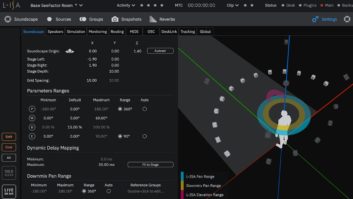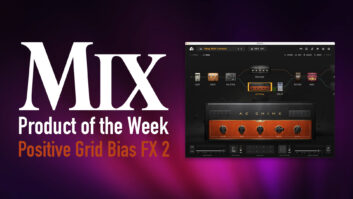Back in the spring of 1983, the great banjo player Bela Fleck and I teamed up for the first time to record his album Deviation. It featured a new fiddle player in Nashville, Mark O’Connor, Kenny Malone on drums, Jerry Douglas on dobro, Sam Bush on mandolin and other members of New Grass Revival. If you can find a vinyl copy of this album, pick it up. You will hear the musical emergence of what would become the Flecktone sound. From that first project through the albums Bela produced with Edgar Meyer, Maura O’Connell, Nashville Bluegrass Band and others, I would be Bela’s recording engineer.
Deviation was recorded on an MCI 600 console and an MCI JH-24 analog machine. Things have changed a lot since those days, and Bela and I have used just about every format to record his albums since then. The new Warner Bros. album, Tales From the Acoustic Planet, Vol. 2, was recorded, edited and mixed totally in Pro Tools 24-bit. Those that know me as an ol’ analog dog should now change that phrase to a DSP hog. One thing about Pro Tools, though-there will probably never be enough Farm cards for me. I can rapidly eat up DSP-like honey to a bear.
On many of the albums recorded in the past, splicing/editing 2-inch tape was the norm. When we recorded the Flecktone albums, we went to offsetting two machines to edit and used that method for years. While recording the first Tales From the Acoustic Planet, released in April 1995, an MTR-100A with 143 remote and Dolby SR was used. Again, editing was done by offsetting two machines. During the making of that album, Pro Tools had made its entrance into Nashville. One of the rooms at Masterfonics where the editing for Tales 1 was being done had a small Pro Tools system in use in another control room. Seeing the ease of how editing could be done in Pro Tools, we saw that this would be the way for Bela to edit future albums. Since the Flecktones’ live album, Live Art, Bela has increased his Pro Tools system to now include three 888s, Apogee 8000, two Glyph 9-gig rack mount hard drives, and three 9-gig and two 18-gig removable hard drives that go with the Glyph four-space rack. A Power Mac 9600 is the heart of the system, with 128 megs of RAM and a DLT backup system. The computer has a full complement of plug-in toys, including my favorites from Waves. For monitoring, Bela likes the Meyer HD-1 self-powered near-field speakers, running from a Bryston preamp. The cue system is a Don Cruz “Music Row Technology: Active Cue System” that will drive four clean, separate stereo mixes to the musicians.
We started this new project on December 18, 1998, by trying out various mics and mic pre combinations on Bela’s banjos. A couple of days before Christmas there was a heavy ice storm that covered the roads for days. Most people in Nashville were iced in for Christmas, as I was. I’m glad I finished the outline of what was needed early, because Bela wanted to record this acoustic album at his home just outside of Nashville and there was much to do and to set up to get ready to record.
Four of the musicians would be performing in the dining room. It’s a basic rectangle, with two recessed octagons in the ceiling where a chandelier hung high from the middle. The house sits well off the road, so the two windows that face the road were the only sources of possible external traffic noise. The room also had one large double-wide open doorway that leads to the living room; a single doorway to the kitchen, both without doors. These were the other sources where random noises could appear. The challenge was to change this room into an environment that would isolate the four instruments from leaking into the other mics while they all played live. Also, there would be no nails, tape or anything that would be adhered to the walls in that or any of the other rooms where different musicians would be.
So starting on December 30, the setup for the album began. The double-wide opening in the dining room was filled with a large piece of closed cellular foam. Other foam was used in different parts of the room along with tube traps to dampen the standing waves. So that each of the four musicians in the dining room-Jerry Douglas on dobro, Tony Rice on guitar, Sam Bush on mandolin and Bela on banjo-could see each other, foam pads were placed as an off-centered X. The musicians faced each other, Sam to Tony, Jerry to Bela. All the instruments were stereo miked. The floor was tongue-and-groove oak that I wanted to keep for the resonance factor around each musician. In the corners where the ceiling meets the floor, I put about a 2-foot width of folded carpet, and around the heat duct as well. Three other rooms were also used, so they needed treatment also. A four-camera video setup allowed all the musicians in the different rooms to see each other. Helping me with the sonic end of things was Richard Battaglia, the sound reinforcement engineer with New Grass Revival when Bela played with that prominent bluegrass group from 1981 to 1989. Just before New Grass Revival broke up, Bela started the Flecktones and recorded their first album. When New Grass Revival split up, Richard went full-time with the Flecktones. Richard has been at all of the Flecktone sessions since the second album, Flight of the Cosmic Hippo. He and I are old friends and we have enjoyed working together.
On the afternoon of January 4, 1999, musicians started to arrive and the shoot-outs between mic and mic pre combinations were done on each of them. Over that last couple of decades, I have collected various mics and mic pre’s, so finding the combinations that musicians liked was not that hard. For microphones, this time I used a Sanken 31 and 32 on guitar, AT 4033 and Neumann KM84 on mandolin, U67 and a 47 on dobro, and U47 and KM54 on banjo. John Hartford’s vocals were recorded on a U47, with a Sony C-37 on his banjo. After dinner we started to record, beginning with “Blue Mountain Hop.” By 10:30 that night, that song was in the can.
The whole week of recording went very smoothly. We averaged about nine gigs per song, and ended up with 18 songs for the album. Each night before we left, backups were run to the DLT. In the morning, the backup would be done. For those of you who use Pro Tools, you know how important it is to back up data. I recommend it without question. And don’t forget to save often during tracking. After the tracking was done, Bela went out on tour. He would edit the tracks when he would get home for a few days at a time. During that time I was able to finish seven other albums. By the time we got back together, it was late March and time to go over the mixes.
I have to confess that mixing on the computer is still rather strange to me. I am a fader kind of guy, and I like to grab a send and turn it. So chasing a mouse around is fine for me when I’m writing on a computer, but musically, mouse-chasing for a mix is not me. It takes too much time. When the mixes were finished, we transferred them from Pro Tools to the Sony 9000 at 24-bit/44.1k. We mastered the album with Denny Purcell at Georgetown Masters on Friday, March 28.
Because all of the players involved with this album have known each other for so long, the stories, jokes and humorous times during this session will stay with us all for years to come. One interesting story that I can share with you happened on January 8, in the evening. Bela’s wife came up to hear a playback and mentioned to Bela that it was Earl Scruggs’ birthday. Bela called Earl’s home, and we all sang “Happy Birthday” to him over the phone. Shortly after that we recorded “Ode to Earl.” Earl Scruggs, by the way, came in at a later date to record a duet with Bela for this album. That’s the way it went with this album-old friends getting together to make some beautiful music.







